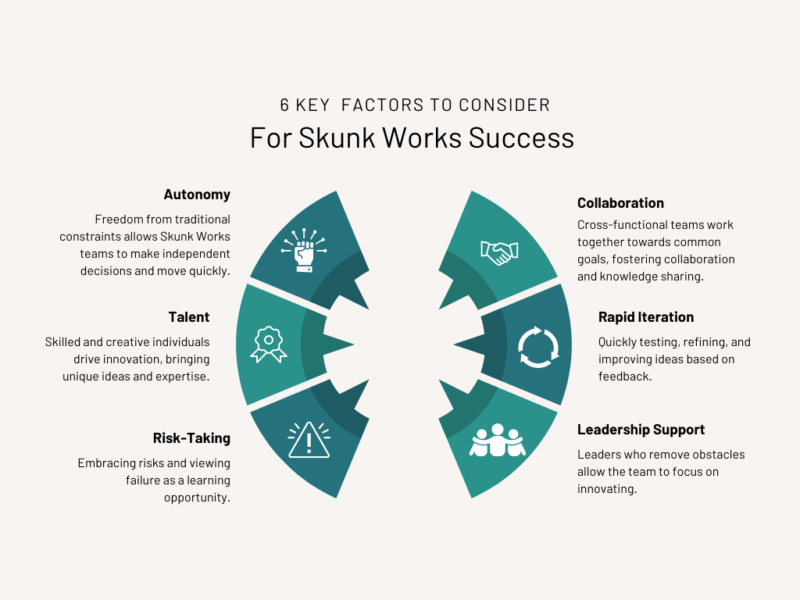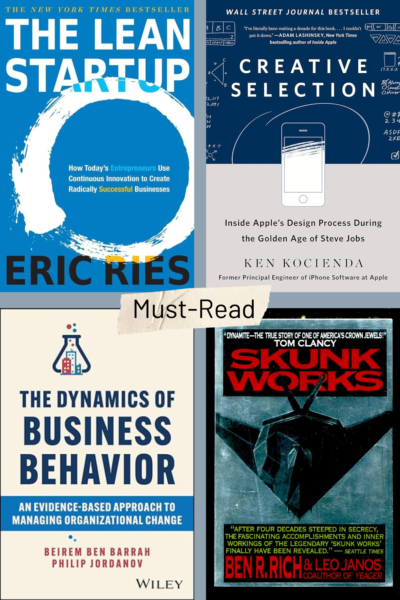
Skunk Works: On Innovation in Large Organizations
This article on Skunk Works is written by Peter van Gorsel and co-authored by Aisha Abdelhafez.
In the corporate world today, Skunk Works refers to a small, elite group within a larger organization that focuses on innovative or secret projects. These teams often operate with a high degree of autonomy and secrecy, enabling them to move quickly and sidestep the bureaucratic red tape that typically hinders innovation. But where does it come from? And what lessons can anyone learn from this idea?
The Origin of Skunk Works
The term “Skunk Works” has an intriguing origin story, dating back to a secret World War II project within Lockheed Corporation’s Advanced Development Projects Division. This division had the crucial task of developing advanced aircraft designs for the United States military. Interestingly, the name “Skunk Works” was inspired by a 1930s comic strip, “Li’l Abner,” created by Al Capp. In the comic, there was a remote and quirky moonshine operation known as “Skonk Works.” The term “skonk” was slang for moonshine, referring to the illegally produced or smuggled distilled spirits, typically whiskey, made and sold without government oversight or taxation.
Kelly Johnson, the brilliant engineer who led the Skunk Works division, embraced this quirky name for their secretive project. Over time, “Skunk Works” became synonymous with highly innovative and confidential research and development efforts. The concept spread beyond Lockheed and became a staple in various industries that thrive on cutting-edge or classified projects. The name “Skunk Works” encapsulates the covert and independent spirit that characterized the division’s operations, setting a standard for future innovative teams.
This historical tidbit adds a layer of depth to the term and underscores the importance of fostering environments where innovation can thrive away from the watchful eyes of standard corporate oversight. So, next time you hear about a groundbreaking project shrouded in secrecy, there’s a good chance it has some Skunk Works DNA at its core.
Skunk Works Failures
Before exploring some success stories it’s important to mention that not every Skunk Works project is a home run. Here are three times when ambitious innovation plans didn’t quite hit the mark:
1. Google Glass: Remember the excitement around Google Glass? Google’s Skunk Works division, Google X, aimed to revolutionize wearable tech with augmented reality glasses. But the reality was less glamorous. Privacy concerns, limited functionality, and a high price tag were major stumbling blocks. By 2015, Google stopped consumer sales, showing that even tech giants can stumble when their innovations outpace practical use.

2. Amazon Fire Phone: Amazon’s Fire Phone was supposed to be a game-changer, designed by a Skunk Works-like team to rival Apple and Samsung. It featured a unique 3D interface and seamless Amazon integration. Yet, consumers weren’t impressed. High prices, a lack of apps, and mediocre reviews sealed its fate. By 2015, Amazon had discontinued it, a reminder that even bold ideas need the right execution to succeed.

3. Microsoft Kin: Targeting young users, Microsoft’s Skunk Works team rolled out the Kin phones. Despite heavy investment and marketing, the phones didn’t catch on. Limited features, high prices, and no support for third-party apps left consumers cold. Just a few months after their 2010 launch, Microsoft pulled the plug, highlighting a major misstep in their mobile strategy.

These examples show that Skunk Works projects can fail for many reasons – high costs, privacy concerns, poor market fit, and more. Even with the freedom to innovate, success isn’t always a sure thing!
Skunk Works Success Stories
Obviously, there’s Lockheed Martin’s original Skunk Works, under the leadership of Clarence “Kelly” Johnson. This team was behind some of the most iconic aircrafts ever, including the P-80 Shooting Star, U-2 spy plane, SR-71 Blackbird, and F-117 Nighthawk stealth fighter. These groundbreaking planes pushed aviation technology to new heights and played critical roles in military operations. This could be seen as the start of the Skunk Works’ reputation for innovation and excellence.
Some Skunk Works projects have not only hit the mark but also left a lasting impression, giving their companies a serious edge. In the early 1980s, a team led by Steve Jobs took on the challenge of developing the Apple Macintosh. Despite facing resistance within Apple, they launched the Macintosh in 1984. This personal computer, with its graphical user interface, revolutionized the industry, setting the stage for Apple’s future success.
And who can forget the Toyota Prius? Developed by a Skunk Works team within Toyota in the late 1990s, the Prius became the world’s first mass-produced hybrid car. Despite industry skepticism, the team launched the Prius in 1997. It quickly became a symbol of eco-friendly transportation, paving the way for the hybrid and electric vehicles that are so popular today.
Key Success Factors of Skunk Works Projects
What makes Skunk Works projects stand out? It’s a mix of freedom, talent, and smart risk-taking. These teams thrive because they aren’t bogged down by corporate red tape. They move fast and think big, driving innovation without constantly looking over their shoulders. The people on these teams are passionate and creative, chosen for their ability to think outside the box. Their unique vision pushes projects forward, turning ambitious ideas into reality. Having clear goals helps too. Everyone knows what they’re aiming for, which keeps the team focused and energized.
Embracing risk is a big part of the culture. These teams aren’t afraid to take bold steps and learn from their mistakes, which accelerates their progress. They also know when to collaborate. Even though they operate independently, they pull in resources and expertise from the larger organization when needed, ensuring they have everything necessary to tackle tough challenges. Rapid iteration is another key ingredient. Constantly testing, refining, and improving ideas based on real-time feedback keeps the project dynamic and responsive. Strong leadership support is crucial as well. Leaders who champion the project and clear away obstacles allow the team to focus on what they do best – innovating. In other words, there is a high need for psychological safety.
When you mix these elements, you have a recipe for successful innovation. Skunk Works projects create environments where innovation isn’t just possible, it’s nearly inevitable. Bold ideas turn into incremental and disruptive advancements, showcasing what’s possible when the right conditions come together.

Some Biases that affect Innovation
Even with all the right ingredients, Skunk Works projects can still stumble due to various biases. Here are a few key ones to watch out for:
- Confirmation Bias: Teams can get overly attached to their initial ideas, seeking out information that supports their beliefs while ignoring contradictory evidence. This tunnel vision can stifle innovation by preventing teams from considering new perspectives or alternative solutions.
- Overconfidence Bias: Confidence is great, but overconfidence can be a trap. When teams become too sure of their abilities or the project’s success, they may underestimate risks or overlook potential challenges. This can lead to poor decision-making and insufficient contingency planning.
- Groupthink: When everyone is on the same page, it can sometimes mean no one is challenging the status quo. Groupthink occurs when teams become insulated from outside opinions and overly reliant on consensus. This can narrow viewpoints and stifle creativity, as dissenting ideas are discouraged.
- Anchoring Bias: Initial ideas can become anchors that are hard to let go of, even when new information suggests a change in direction. This bias can prevent teams from adapting to changing circumstances or exploring more effective solutions.
Recognizing and addressing these biases is crucial for maintaining the innovative edge of Skunk Works projects. By staying open to diverse perspectives, encouraging critical thinking, and being willing to pivot when necessary, teams can navigate these challenges and keep the innovation flowing.
Mitigating These Biases
To keep Skunk Works projects on the path to success, tackling biases is essential. Embracing diverse perspectives helps avoid groupthink and confirmation bias. By bringing together team members with varied backgrounds, you spark fresh ideas and uncover hidden blind spots. This mix of viewpoints helps ensure that no stone is left unturned.
Creating a culture where constructive dissent is encouraged is just as important (for example with Red-Blue Team). When team members feel safe to challenge assumptions and voice different opinions, it prevents overconfidence and anchoring biases. This open environment promotes critical thinking and ensures all ideas are rigorously tested and refined. Thorough analysis also plays a key role. By relying on evidence-based decision-making, teams can avoid confirmation and projection biases. Systematic data evaluation leads to more objective decisions and a clearer understanding of the potential impact of ideas.
Agile methodologies keep projects flexible and responsive. Practices like rapid prototyping and continuous feedback loops allow teams to quickly test and refine concepts, minimizing the risk of sticking to flawed assumptions. This approach helps Skunk Works teams stay nimble and adapt to new information swiftly.
By incorporating strategies such as these, Skunk Works teams create an environment where innovation thrives and biases are kept in check. This proactive approach not only fuels creativity but also significantly boosts the chances of project success.
Skunk Works in Today’s World
Skunk Works-style initiatives are like hidden gems in today’s business world, quietly sparking innovation and problem-solving in surprising ways. Even if they don’t always go by that name, their impact is unmistakable. Here’s how they’re making waves:
- Corporate Innovation Labs: These are the innovation hubs within big companies, where creativity flourishes beyond the usual corporate boundaries.
- Startup Incubators and Accelerators: They’re the launchpads for aspiring entrepreneurs, offering not just resources but also invaluable mentorship to turn dreams into reality.
- Government Research Agencies: Behind the scenes, these agencies are tackling big challenges and pushing the limits of what’s possible in science and tech.
- Cross-Functional Project Teams: Imagine a diverse group of experts from different areas coming together like superheroes to crack tough problems and drive innovation.
- Open Innovation Initiatives: These are the innovation gatherings where everyone’s invited—inside and outside the company—to brainstorm, collaborate, and create something amazing.
While the names and setups may vary, the essence remains the same: a dedication to thinking outside the box and forging ahead, no matter the obstacles.
Skunk Works Through The Ages
During pivotal moments like the Industrial Revolution, inventive minds often operated in a manner reminiscent of modern Skunk Works projects. Take James Watt, whose clandestine improvements to the steam engine in the 18th century were nothing short of revolutionary, reflecting the spirit of Skunk Works. Similarly, the construction of the Bridgewater Canal, masterminded by engineer James Brindley, showcased the power of small, dedicated teams pushing boundaries and laying the groundwork for Britain’s industrial transport network. The Lombe Silk Mill in Derby, England, stands as another testament to this era of clandestine innovation, with John Lombe’s water-powered machinery transforming silk production, all while shrouded in secrecy to safeguard his technological advancements.
Though the term “Skunk Works” wasn’t coined then, these pioneering efforts embodied its principles of innovation, experimentation, and discretion. Similarly, Skunk Works-style initiatives continue to thrive in the contemporary business landscape, shaping industries and driving progress.
From Lockheed Martin’s Skunk Works division, responsible for groundbreaking aircraft like the SR-71 Blackbird, to NASA’s Apollo program, which achieved the monumental feat of landing humans on the Moon, these examples demonstrate the enduring effectiveness of skunk works approaches.
While the terminology may have evolved, the essence of Skunk Works—autonomy, innovation, and ambitious goals—remains a driving force behind transformative projects throughout history.
Skunk Works and Innovation
Skunk Works projects are often the driving force behind innovation within organizations. They create environments where creativity flourishes, allowing teams to think outside the box and explore unconventional ideas. By operating with a high degree of autonomy, these teams can take calculated risks and embrace failure as part of the learning process.
The rapid iteration typical of Skunk Works projects means ideas can be tested, refined, and improved quickly, accelerating the pace of innovation. Cross-functional collaboration is key, bringing together diverse expertise to break down silos and foster knowledge sharing.
Ultimately, successful Skunk Works projects can transform organizations. They spark cultural change, inspire new ways of working, and demonstrate the value of agility and creativity. By adopting Skunk Works principles, organizations can become more innovative and responsive, ready to meet future challenges head-on.
Insightful Books with regard to Skunk Works Projects
Dive into the fascinating world of Skunk Works and innovation with these compelling reads:

“Skunk Works: A Personal Memoir of My Years of Lockheed” by Ben R. Rich and Leo Janos: Get an insider’s view of the legendary Skunk Works division at Lockheed Martin. Ben Rich, who led the division, shares riveting tales of developing groundbreaking aircraft like the U-2 spy plane and the SR-71 Blackbird. It’s a thrilling ride through the highs and lows of pioneering aerospace technology.
“The Lean Startup” by Eric Ries: Discover how the principles of lean startups—rapid iteration, customer feedback, and validated learning—can supercharge any skunk works-style project. Eric Ries offers practical insights that are essential for fostering innovation and agility in any organization.
“Creative Selection” by Ken Kocienda: Go behind the scenes at Apple during the Steve Jobs era. Ken Kocienda reveals the secrets of Apple’s product development process, sharing firsthand experiences from working on the original iPhone and iPad. It’s an eye-opening look at how a skunk works approach drove some of the most iconic innovations in tech.
“The Dynamics of Business Behavior” by Beirem Ben Barrah and Philip Jordanov: This book explores psychological biases that can impact Skunk Works-like projects and offers strategies (evidence-based change interventions) to harness creativity and imagination in the context of driving organizational change. We’re obviously a bit biased as Neurofied’s founders wrote it but many have told us it’s an insightful read for those who want to understand the human dynamics behind successful innovation.
We hope you found this article on Skunk Works useful!
About Neurofied
Neurofied is a behavioral science company specialized in training, consulting, and change management. We help organizations drive evidence-based and human-centric change with insights and interventions from behavioral psychology and neuroscience. Consider us your behavioral business partner who helps you build behavioral change capabilities internally.
Since 2018, we have trained thousands of professionals and worked with over 100 management, HR, growth, and innovation teams of organizations such as Johnson & Johnson, KPMG, Deloitte, Novo Nordisk, ABN AMRO, and the Dutch government. We are also frequent speakers at universities and conferences.
Our mission is to democratize the value of behavioral science for teams and organizations. If you see any opportunities to collaborate, please contact us here.
